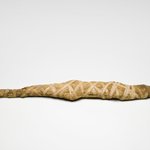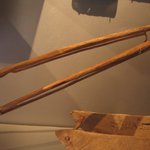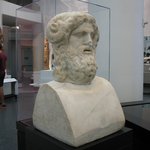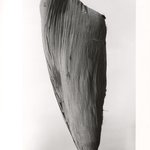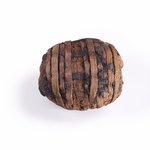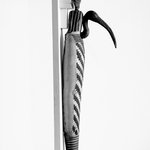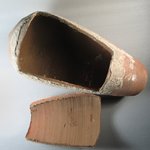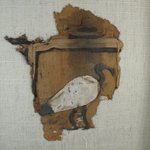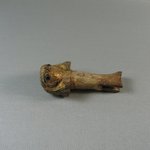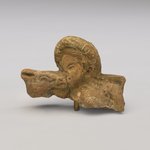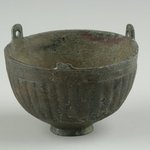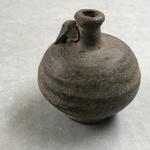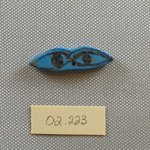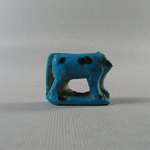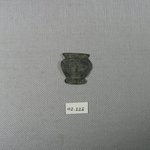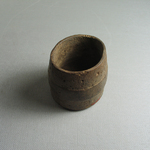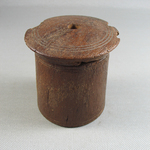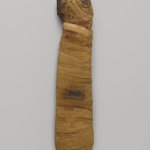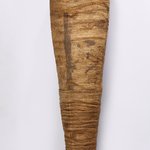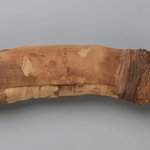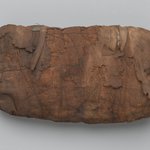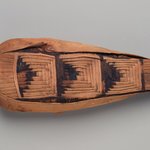
Ibis Mummy
Egyptian, Classical, Ancient Near Eastern Art
The ideal votive animal mummy, as shown in the X-ray here, contains one animal wrapped in the linen package. Yet without an X-ray or CT scan, it is impossible to know whether an additional animal, or no animal at all, was included in the wrappings.
Egyptians of the first millennium b.c.e. believed that they could appeal to the god Thoth to intercede in human affairs. Ibis mummies allowed such a petitioner to send a message to the god.
Egyptians of the first millennium b.c.e. believed that they could appeal to the god Thoth to intercede in human affairs. Ibis mummies allowed such a petitioner to send a message to the god.
MEDIUM
Animal remains (female glossy ibis), linen
DATES
30 B.C.E.– 100 C.E.
PERIOD
Early Roman Period
DIMENSIONS
4 3/4 × 3 5/8 × 12 3/4 × 14 1/2 in. (12.1 × 9.2 × 32.4 × 36.8 cm)
as mounted: 7 7/8 × 5 1/2 × 16 3/4 in. (20 × 14 × 42.5 cm) (show scale)
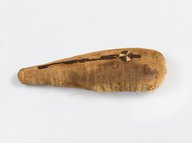


COLLECTIONS
Egyptian, Classical, Ancient Near Eastern Art
ACCESSION NUMBER
14.652
CREDIT LINE
Gift of the Egypt Exploration Fund
MUSEUM LOCATION
This item is not on view
CAPTION
Ibis Mummy, 30 B.C.E.– 100 C.E. Animal remains (female glossy ibis), linen, 4 3/4 × 3 5/8 × 12 3/4 × 14 1/2 in. (12.1 × 9.2 × 32.4 × 36.8 cm). Brooklyn Museum, Gift of the Egypt Exploration Fund, 14.652. Creative Commons-BY (Photo: Brooklyn Museum (Gavin Ashworth,er), 14.652_Gavin_Ashworth_photograph.jpg)
IMAGE
overall, 14.652_Gavin_Ashworth_photograph.jpg. Brooklyn Museum photograph (Gavin Ashworth, photographer), 2012
"CUR" at the beginning of an image file name means that the image was created by a curatorial staff member. These study images may be digital point-and-shoot photographs, when we don\'t yet have high-quality studio photography, or they may be scans of older negatives, slides, or photographic prints, providing historical documentation of the object.
RIGHTS STATEMENT
Creative Commons-BY
You may download and use Brooklyn Museum images of this three-dimensional work in accordance with a Creative Commons license. Fair use, as understood under the United States Copyright Act, may also apply.
Please include caption information from this page and credit the Brooklyn Museum. If you need a high resolution file, please fill out our online application form (charges apply).
For further information about copyright, we recommend resources at the United States Library of Congress, Cornell University, Copyright and Cultural Institutions: Guidelines for U.S. Libraries, Archives, and Museums, and Copyright Watch.
For more information about the Museum's rights project, including how rights types are assigned, please see our blog posts on copyright.
If you have any information regarding this work and rights to it, please contact copyright@brooklynmuseum.org.
RECORD COMPLETENESS
Not every record you will find here is complete. More information is available for some works than for others, and some entries have been updated more recently. Records are frequently reviewed and revised, and we welcome any additional information you might have.



